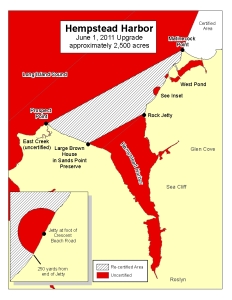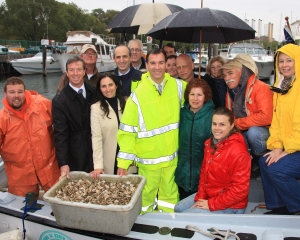Hempstead Harbor becomes NY’s second-highest producer of hard clams, adds nearly $1.36 million in value to local economy, says director of Hempstead Harbor Protection Committee
In yet another sign that water-quality efforts are a worthwhile investment, New York State Department of Environmental Conservation (NYS DEC) statistics for 2014 indicate that Hempstead Harbor has become the state’s second largest producer of hard clams. Hempstead edges out Huntington Harbor, which has long held that claim. The largest producer remains Oyster Bay/Cold Spring Harbor.
For 2014, NYS DEC statistics show that a total of 17,303 bushels of hard clams were harvested from the harbor with a value of nearly $1.36 million.

After having been closed to shellfishing for 45 years, a 2,500 acre area of the outer harbor was re-opened in 2011, after years of extensive testing showed that the area consistently met stringent water quality standards required for shellfish harvesting.
The DEC’s Bureau of Marine Resources (BMR) initiated a sanitary survey of the area in August 2004, after observing commercial shellfish harvesters working in Long Island Sound, just east of Matinecock Point. Routine water quality monitoring conducted over the next four years indicated that water quality in outer Hempstead Harbor was meeting the bacteriological criteria for certified areas, where shellfish can be taken for human consumption. FDA assisted with a required dye study. BMR also worked cooperatively with the Town of Oyster Bay and the Coalition to Save Hempstead Harbor to collect and examine additional water samples to evaluate the effects that significant volumes of non-point source runoff after moderate to heavy rainfall events had on water quality in outer Hempstead Harbor.
Testing of water samples conducted over more than five years showed levels of fecal bacteria in approximately 2,500 acres of outer Hempstead Harbor and Long Island Sound met the stringent state and federal standards for a certified (open) shellfishing area. Additionally, hard clam samples from the area were tested for the presence of various metals, PCBs, dioxins, furans, pesticides, and radioactive elements. The data as reviewed by the New York State Health Department concluded that the potential exposure from eating shellfish from the newly certified waters would not be a health concern.

Since the water quality necessary for certifying shellfish areas is the highest water quality standard that there is for saline waters, this marked a tremendous turn-around since 1971 when Newsday published a six page exposé entitled “Who’s Killing Hempstead Harbor.”
This turn-around is the result of many factors, beginning with the elimination of many industrial uses around the harbor over the past forty years (e.g., conversion of the Roslyn wastewater treatment plant to a pump station) and numerous water quality improvement efforts. Additionally, natural processes have renewed and improved the harbor’s ecosystem.
Through New York State’s Water Quality Improvement Project (WQIP) program, the NYS DEC used funding from the Environmental Protection Fund and 1996 Clean Water/Clean Air Bond Act to provide approximately $8 million to area municipalities to conduct a number of projects that improved Hempstead Harbor’s water quality. Many municipalities around the harbor have implemented Stormwater Management Program Plans to reduce the impact of runoff on local water bodies. Also contributing to the opening of the outer Hempstead Harbor to shellfishing was the establishment of a vessel waste No Discharge Zone for the Harbor in 2008, which was spearheaded by the Hempstead Harbor Protection Committee.
Since the underwater lands in the designated shellfish area are state owned, anyone may harvest shellfish (clams, oysters, mussels and scallops) consistent with NYS DEC permit requirements and daily harvest limits and size limits for the various types of shellfish.
 Town of North Hempstead Supervisor Judi Bosworth said, “This dramatic turnaround for Hempstead Harbor is such encouraging news, and this robust harvest of shellfish is proof of the continuing improvements in the Harbor’s water quality. The fact that our Harbor has become the state’s second largest producer of clams shows that a strong commitment to cleaning our waterways brings great benefits, environmentally and economically, to North Hempstead.”
Town of North Hempstead Supervisor Judi Bosworth said, “This dramatic turnaround for Hempstead Harbor is such encouraging news, and this robust harvest of shellfish is proof of the continuing improvements in the Harbor’s water quality. The fact that our Harbor has become the state’s second largest producer of clams shows that a strong commitment to cleaning our waterways brings great benefits, environmentally and economically, to North Hempstead.”
Nassau County Legislator Delia DeRiggi-Whitton, whose district encompasses Hempstead Harbor, remarked, “It is so rewarding that my office was able to help fund Hempstead Harbor cleanup efforts that are witnessing undeniable results first hand. The fact that shellfish beds were, not only able to reopen, but produced a record harvest is a strong testament to the work of so many organizations behind this tremendous undertaking. I look forward to the day when we see the rest of Hempstead Harbor and other waterways open to shellfishing.”
Karen Reichenbach, Village Trustee for the Village of Flower Hill, said, “It is a source of great pride and pleasure that we at the Village of Flower Hill have been a part of the revitalization of Hempstead Harbor. In addition to fishing and shellfishing, the Harbor offers so many recreational opportunities for our residents. We congratulate the Hempstead Harbor Protection Committee on their fine work.”
The re-opening of the shellfish beds was the result of years of efforts by many different levels of government, community organizations and stakeholders including the Coalition to Save Hempstead Harbor, area baymen, former Nassau County Executive Thomas Suozzi, the New York State Departments of Environmental Conservation and Health, Suffolk County Cooperative Extension, and the Flower Oyster Company. With cooperation like this, success was inevitable!
By Eric Swenson, Executive Director of the Hempstead Harbor Protection Committee
